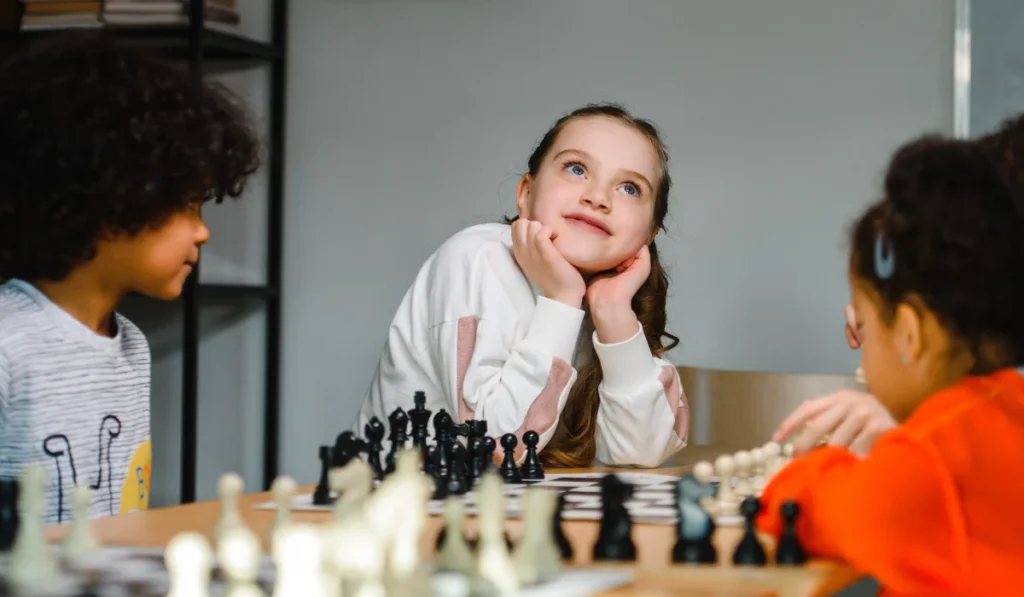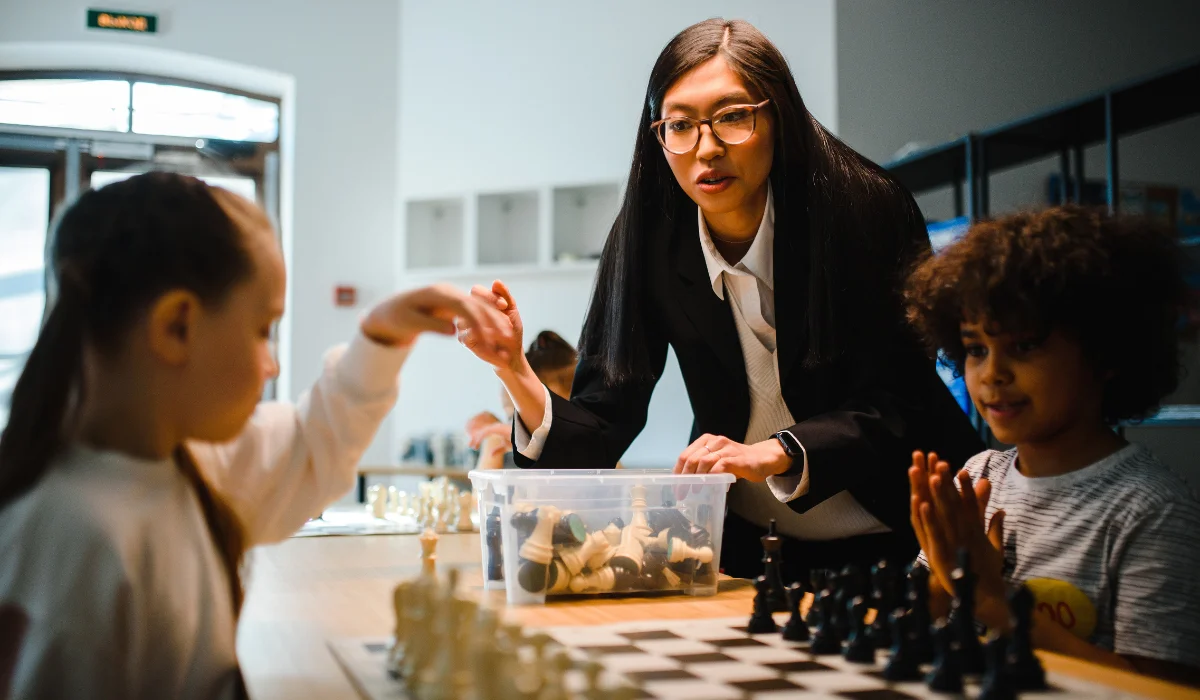Chess, a game of deep strategy and tactical precision, can sometimes seem daunting for your 5-year-old children. However, with the right approach, teaching children the basics of this centuries-old game can not only be engaging but also highly beneficial.
Research data has demonstrated that learning chess can enhance children’s problem-solving abilities, improve memory, and foster critical thinking skills. This article explores effective ways to introduce basic chess strategies to 3 to 8-year-old children, designed to make the game more accessible and enjoyable while encouraging cognitive development.
To help you find the most effective way, we’ve gathered 8 expert tips from parents and teachers. From teaching forking with imagination to making learning chess fun and exciting, discover the best methods to introduce a young child to the world of chess.
- Teach Forking With Imagination
- Use a Fun Family Chess Set
- Introduce Chess via Mini-Games
- Guide Through the Basics Incrementally
- Engage With a Storytelling Approach
- Teach Pawn Movement and Control
- Utilize YouTube for Chess Education
- Infuse Fun and Enthusiasm into Chess Lessons
Check Out the 8 Effective Ways to Teach Basic Chess Strategies to Young Children Below:
1. Teach Forking With Imagination
One effective way to teach basic chess strategy to a 6-year-old is by teaching them the concept of forking. This occurs when a piece makes two simultaneous threats, such as attacking two other pieces or putting an opposing king in check with two different pieces. To illustrate this concept, you could have them imagine each chess piece as having wings and pretend that they are flying around the board to attack enemy pieces.
Demonstrate by moving an attacking piece into position and explain how it threatens two opponents simultaneously, making them both vulnerable. For example, setting up a knight between a queen and a bishop can be seen as blocking both pieces at once and making them unable to move in fear of being captured.
— Michael Alexis, CEO, TeamBuilding
See Also: Free Kahoot Alternatives for Creating Online Quizzes
2. Use a Fun Family Chess Set
I recommend starting with games like Fun Family Chess. This simplified chess set features uniquely colored pieces, which can aid in illustrating various tactics. Let me recount a personal experience.
My little nephew, barely 6, was eager to learn chess. I introduced him to Fun Family Chess, showing him how each piece moved using the color-coded characters. We played for an hour daily, focusing on one piece each week.
First, I demonstrated the pawn’s movements, allowing him to experiment with eight pawns on the board. The next week, we explored the rook, enabling him to visualize straight lines across the board.
Gradually, through a systematic four-week process, we covered the primary pieces and started putting them together. This intuitive, interactive method proved highly effective, and he started developing basic strategies within a month.
— Ben McInerney, Director, Go Tree Quotes
3. Introduce Chess via Mini-Games
One effective strategy to teach chess to a 6-year-old is through playing mini-games. Mini-games simplify the complex game of chess by focusing on a specific subset of pieces.
For instance, you could start with a “Pawn Game.” Set up the board with only pawns for both sides. The goal is to get a pawn to the other side of the board. This game helps the child understand pawn movement and the concept of promotion.
Next, you might introduce the rooks, playing a game where the objective is to capture the opponent’s rook. This helps them understand how rooks move and capture.
Mini-games gradually introduce the complexity of chess, helping the child understand the unique movements and roles of each piece. Remember to make it fun and provide positive reinforcement as they learn.
— Josh Amishav, Founder and CEO, Breachsense
4. Guide Through the Basics Incrementally
Begin with the basic information, such as the names of the pieces and how they move, and make sure they grasp all this entirely before moving on to more complex rules. Also, it’s crucial to remember to reveal even these lessons gradually rather than talk about them all at once.
Help the child get accustomed to the simpler ones, and use them to play a few games—even when the games are still far from being labeled chess. Help the little ones get acquainted with the pieces and everything they do first. Once they know these fundamentals, the other instructions will be easy to follow.
— Riley Beam, Managing Attorney, Douglas R. Beam, P.A.
Also Read: Best GeoGuessr Alternatives (Free)
5. Engage With a Storytelling Approach

Children have a natural fondness for stories, and when you make a strategy engaging and relatable, they are more likely to retain it. For instance, you can narrate a tale about a courageous knight who embarks on a mission to safeguard his king from an impending enemy assault. Following that, you can elucidate how chess mirrors this narrative by assigning distinct powers and purposes to each game piece, just like the knight in the story.
To effectively convey this strategy, I’d arrange a chessboard with only a few pieces, such as the king, queen, and knight. I’ll demonstrate the knight’s movement, which resembles an L-shape and allows it to leap over other pieces. I’ll use storytelling to illustrate how the knight safeguards the king by being positioned in front of him or swiftly neutralizing any adversaries that venture too close.
— Johannes Larsson, Founder and CEO, JohannesLarsson.com
6. Teach Pawn Movement and Control
One effective way to teach basic chess strategy to a 6-year-old is to start by teaching them how to move their pawns and control the center of the board. Explain to the child that pawns move forward and capture diagonally. Then, demonstrate how controlling the center of the board can give them an advantage in the game.
Show them how to use their pawns to occupy the central squares and restrict the opponent’s movement. This strategy is easy to understand and can form a solid foundation for more advanced chess play. Encourage the child to practice this strategy during gameplay and make adjustments based on their opponent’s moves.
— Basana Saha, Founder, KidsCareIdeas
7. Utilize YouTube for Chess Education
After a break, I’ve recently picked up chess again. During the past year, I attempted to teach my 6-year-old nephew how to play. However, I soon realized that my teaching skills were not the best fit for him.
To find a solution, we decided to explore YouTube together, where we stumbled upon an abundance of videos specifically created to teach children how to play chess.
We started watching those videos, and whenever needed, I would pause and provide additional explanations to clarify any questions. This approach turned out to be highly effective in teaching the basic strategy of chess.
— Evan McCarthy, President, and CEO, SportingSmiles
8. Infuse Fun and Enthusiasm into Chess Lessons
Make it fun, exciting, and adventurous, and you’ll have a child’s undivided attention! For starters, you can curate a selection of chess-themed films or animated series to spark their interest. The next thing to do is play together, demonstrate different tactics playfully, and excitingly share the logic behind specific moves.
As long as you present every piece of info in entertaining and engaging ways, they will remain interested and pick up each skill quickly. You can also try different approaches. For example, if a child responds to colors well, using colorful pieces will make the learning visually pleasing and encourage the child to get involved.
— Neil Platt, Director, Emerald Home Improvements
Related: How to Make Online Classes Interesting
Final Words
In conclusion, teaching chess to young children can be an enriching and rewarding endeavor. The eight strategies discussed in this article are designed to make the game accessible, enjoyable, and educational for youngsters. By simplifying complex concepts, fostering a supportive learning environment, and keeping the game engaging, we can help children discover the joy of chess.
As they learn, they will also develop crucial cognitive skills that will serve them in many areas of life beyond the chessboard. Remember, every grandmaster began as a novice, and with patience and the right strategies, our young learners may just be taking their first steps on the path to mastering this timeless game.
Brett Farmiloe is the founder & CEO of Featured.com, a question-and-answer platform that connects brands with expert insights. He is a published author and has been involved with a couple of successful acquisitions (and multiple failures) with startups.





















